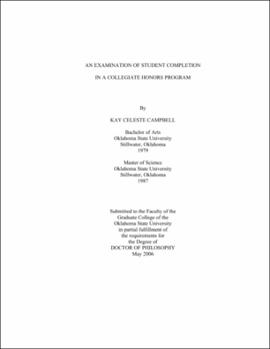| dc.contributor.advisor | Fuqua, Dale | |
| dc.contributor.author | Campbell, Kay Celeste | |
| dc.date.accessioned | 2013-11-26T08:34:16Z | |
| dc.date.available | 2013-11-26T08:34:16Z | |
| dc.date.issued | 2006-05 | |
| dc.identifier.uri | https://hdl.handle.net/11244/7335 | |
| dc.description.abstract | Scope and Method of Study: Although student persistence in college is a heavily researched topic, persistence and completion in collegiate honors programs has received very little research attention. The purpose of this study was to identify variables that predicted completion in a collegiate honors program, to evaluate the relative predictive importance of these variables, and to use these variables to describe how the completion groups differed. The subjects of the study were 336 Oklahoma State University freshman honors program participants in Fall 2000. After five years, the subjects were classified into three completion groups: (1) completers - those who completed the Honors Program Degree, requiring 39 honors credit hours (N = 62); (2) partial completers - those who completed the General Honors Award, requiring 21 honors credit hours (N = 73); and (3) noncompleters - those who completed no honors awards (N = 201). Preliminary univariate analyses were performed using an initial set of 16 pre- and post-college-entry predictor variables that were grounded in Tinto's (1993) longitudinal model of institutional departure. Subsequent multivariate predictive discriminant analyses were performed using the nine variables that showed a significant univariate relationship with the criterion grouping variable: high school GPA; ACT score; high school class rank; first-semester college GPA; first-semester college credit hours earned; first-semester-credit-hour enrollment in honors courses; gender; field of study (college of initial enrollment); and initial residence (honors residence hall or other housing). | |
| dc.description.abstract | Findings and Conclusions: The discriminant analysis produced one statistically significant discriminant function (Rc = .50; Wilk's lambda = .73; x2 = 94.11; df = 16; p < .01). The set of variables predicted the level of honors award completion moderately well, classifying 54.28% of the students into the correct completion group (a 31% improvement over random assignment as measured by the proportional reduction in error). The findings suggest that, when compared with both completers and partial completers, noncompleters had significantly lower cumulative first-semester GPAs, lower high school GPAs, and lower class ranks. They were also less likely to live in honors housing their first semester and were more likely to be males. Theoretical and practical implications are discussed, as well as implications for future research. | |
| dc.format | application/pdf | |
| dc.language | en_US | |
| dc.rights | Copyright is held by the author who has granted the Oklahoma State University Library the non-exclusive right to share this material in its institutional repository. Contact Digital Library Services at lib-dls@okstate.edu or 405-744-9161 for the permission policy on the use, reproduction or distribution of this material. | |
| dc.title | Examination of student completion in a collegiate honors program | |
| dc.contributor.committeeMember | Miller, Janice | |
| dc.contributor.committeeMember | Perry, Kayte | |
| dc.contributor.committeeMember | Hyle, Adrienne | |
| dc.contributor.committeeMember | Choike, James | |
| osu.filename | Campbell_okstate_0664D_1739.pdf | |
| osu.accesstype | Open Access | |
| dc.type.genre | Dissertation | |
| dc.type.material | Text | |
| thesis.degree.discipline | Educational Psychology | |
| thesis.degree.grantor | Oklahoma State University | |
